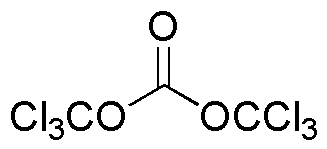Triphosgene is widely utilized in research focused on:
- Pharmaceutical Synthesis: It serves as a versatile reagent in the production of various pharmaceuticals, enabling the formation of carbonates and isocyanates, which are crucial in drug development.
- Polymer Chemistry: Triphosgene is used in the synthesis of polycarbonates, which are essential for producing durable plastics and coatings, offering excellent thermal stability and impact resistance.
- Agrochemicals: It plays a key role in the formulation of pesticides and herbicides, enhancing the efficacy and stability of active ingredients, thereby improving agricultural productivity.
- Laboratory Reagent: In research settings, it is employed for carbonylation reactions, allowing scientists to explore new chemical pathways and develop innovative materials.
- Environmental Applications: Triphosgene is utilized in the production of biodegradable polymers, contributing to sustainable practices in various industries by reducing plastic waste.
General Information
Properties
Safety and Regulations
Applications
Triphosgene is widely utilized in research focused on:
- Pharmaceutical Synthesis: It serves as a versatile reagent in the production of various pharmaceuticals, enabling the formation of carbonates and isocyanates, which are crucial in drug development.
- Polymer Chemistry: Triphosgene is used in the synthesis of polycarbonates, which are essential for producing durable plastics and coatings, offering excellent thermal stability and impact resistance.
- Agrochemicals: It plays a key role in the formulation of pesticides and herbicides, enhancing the efficacy and stability of active ingredients, thereby improving agricultural productivity.
- Laboratory Reagent: In research settings, it is employed for carbonylation reactions, allowing scientists to explore new chemical pathways and develop innovative materials.
- Environmental Applications: Triphosgene is utilized in the production of biodegradable polymers, contributing to sustainable practices in various industries by reducing plastic waste.
Documents
Safety Data Sheets (SDS)
The SDS provides comprehensive safety information on handling, storage, and disposal of the product.
Product Specification (PS)
The PS provides a comprehensive breakdown of the product’s properties, including chemical composition, physical state, purity, and storage requirements. It also details acceptable quality ranges and the product's intended applications.
Certificates of Analysis (COA)
Search for Certificates of Analysis (COA) by entering the products Lot Number. Lot and Batch Numbers can be found on a product’s label following the words ‘Lot’ or ‘Batch’.
*Catalog Number
*Lot Number
Certificates Of Origin (COO)
This COO confirms the country where the product was manufactured, and also details the materials and components used in it and whether it is derived from natural, synthetic, or other specific sources. This certificate may be required for customs, trade, and regulatory compliance.
*Catalog Number
*Lot Number
Safety Data Sheets (SDS)
The SDS provides comprehensive safety information on handling, storage, and disposal of the product.
DownloadProduct Specification (PS)
The PS provides a comprehensive breakdown of the product’s properties, including chemical composition, physical state, purity, and storage requirements. It also details acceptable quality ranges and the product's intended applications.
DownloadCertificates of Analysis (COA)
Search for Certificates of Analysis (COA) by entering the products Lot Number. Lot and Batch Numbers can be found on a product’s label following the words ‘Lot’ or ‘Batch’.
*Catalog Number
*Lot Number
Certificates Of Origin (COO)
This COO confirms the country where the product was manufactured, and also details the materials and components used in it and whether it is derived from natural, synthetic, or other specific sources. This certificate may be required for customs, trade, and regulatory compliance.


